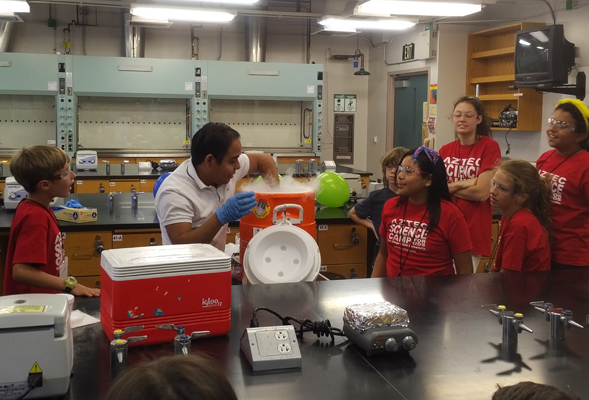Inspiring Future Scientists
One experiment at a time, Aztec Science Camp sparks childrens curiosity for the world around them.

Nearly two dozen children are sitting around a large table inside a laboratory at San Diego State University waiting for the smoke to settle. Their eyes, protected by safety goggles, are trained on an orange cooler. Just minutes before, the kids blew up balloons and placed bets on how many of their balloons could fit inside the cooler.
“This isn’t happening,” shouts one child in disbelief as nearly half the balloons go inside the container. Another child simply exclaims “This is so cool!”
Welcome to Aztec Science Camp.
Gerardo Mendoza, a physics student in physics professor Milton Torikachvili’s lab, is demonstrating the effect liquid nitrogen has on an inflated balloon. As Mendoza effortlessly inserts one balloon after another into the cooler, he explains what the liquid nitrogen does to the balloons.
“The liquid inside this container is really, really cold,” Mendoza said. “It condenses the air inside your balloons into its liquid form and liquids take up less volume than gas, so the balloons shrink.”
The children are no less amazed when Mendoza takes all of their balloons back out of the orange container a few moments later. They watch with their mouths open as their balloons sizzle and crackle on the lab table in front of them while they inflate back to their original size.
Age-appropriate science experiments
Aztec Science Camp was created three years ago to allow children to explore science, technology, engineering and math (STEM) fields and develop their curiosity about the world around them. The camp offers two five-day sessions of science exploration and is open to children ages 7 to 14. Because of the broad age range, children are grouped into age-specific activities.
The 7- to-10-year-olds are Planet Protectors and Toyologists. The 11-to-14-year-olds are Rokenbok Designers and Clue Creators.
Planet Protectors learn about conserving resources and build gadgets that help save energy. Toyologists explore how their favorite toys work and use that knowledge to design their own toys. Rokenbok Designers meanwhile conceptualize, design, and improve their own creations to develop structures.
Thinking like scientists
As for the Clue Creators, Aztec Science Camp co-director Lisa Lamb gets a taste of what they have been working on when she enters their classroom at the end of the first week of camp. She finds one of the camp's interns stirring in a coffee pot filled with a slimy white texture. The intern is racing the clock, trying to find clues that will allow her to exit the “escape room” she is stuck in.
Lamb joins the intern in her search for clues and helps her uncover the key to an old cash register sitting at the far end of the room. Inside, the two women find another clue, eventually leading them to a cassette tape. With just minutes left on the clock, they insert the tape into a cassette player and hear their last clue: a voice recording with the password to escape the room.
“We want these campers to think of themselves as scientists and engineers,” Lamb said. “Camp is also an early introduction to SDSU and our hope is that some of them will remember this fun educational experience when they consider becoming Aztecs in the future.”
Raising the next generation of STEM teachers
But Aztec Science Camp takes the learning experience one step further. It’s not just the children who benefit from their involvement in camp. Their learning experiences are facilitated by lead teachers who are current students or recent graduates in the SDSU teacher credential program. SDSU students enrolled in STEM majors act as camp interns and help supervise the young scientists. The camp is funded in part by a five-year grant from the National Science Foundation designed to educate the next generation of STEM teachers, as well as SDSU’s President’s Leadership Fund, which provided seed money for the project in the year of its inception.
Lamb and her co-director Donna Ross, a science educator in the School of Teacher Education, have also been able to secure funding from the Mathematics and Science Teacher Initiative, Rokenbok Education, the Subaru of America Foundation, the Center for Teaching Critical Thinking and Creativity, and the Center for Research in Mathematics and Science Education.
“Our goal in creating this camp was to spur the undergraduate students’ interest in teaching sciences,” Lamb said.
Back in the physics lab, Torikachvili is preparing the highlight of the young scientists’ day. He rolls the orange container from the lab into the hallway and dumps the contents of the cooler onto the ground in front of him. The children, who are all still holding their colorful balloons, are on their tippy-toes waiting for the “all clear” from Lamb. She gives it after the contents of the container begin to evaporate. As soon as the kids hear the “all clear”, all 20 of them take off screeching in excitement, trying to chase the droplets of liquid nitrogen as they scatter across the ground.



